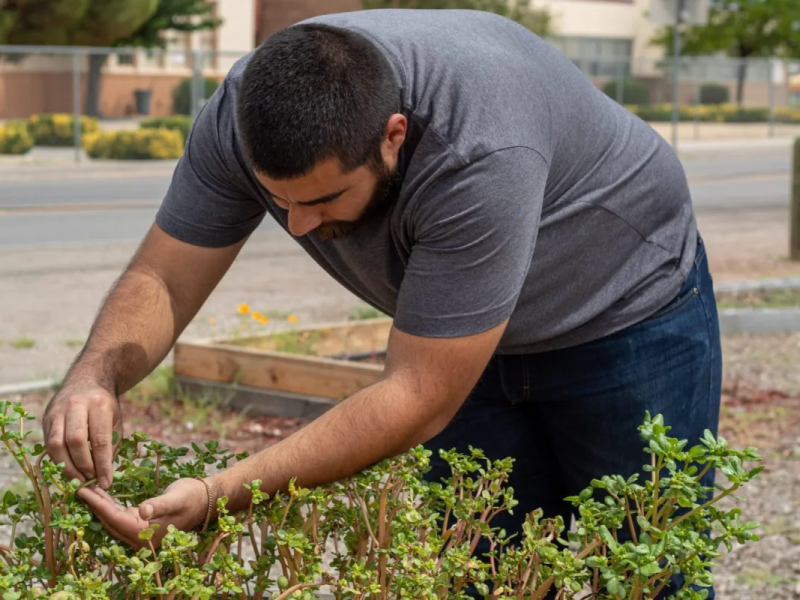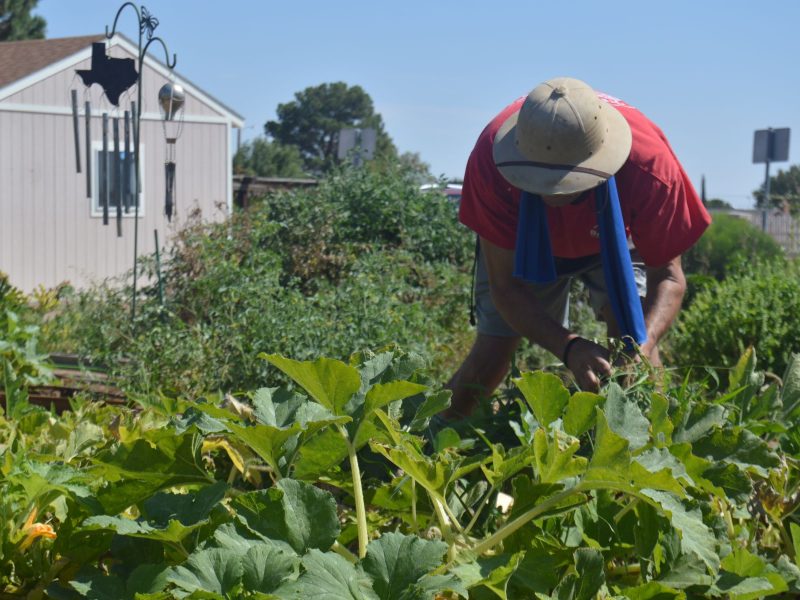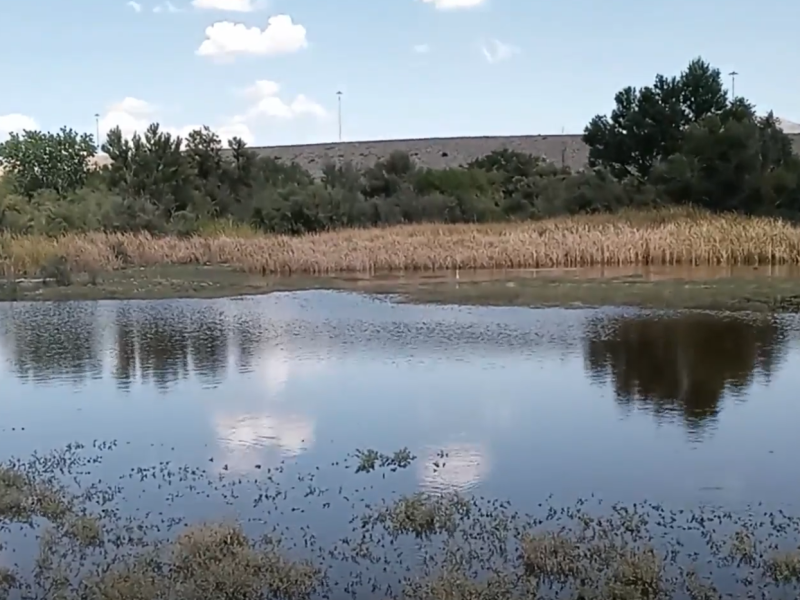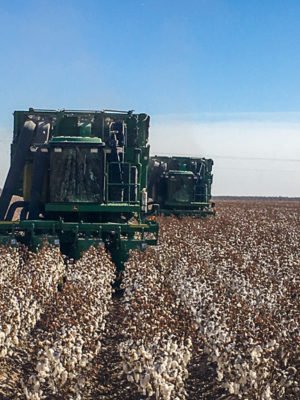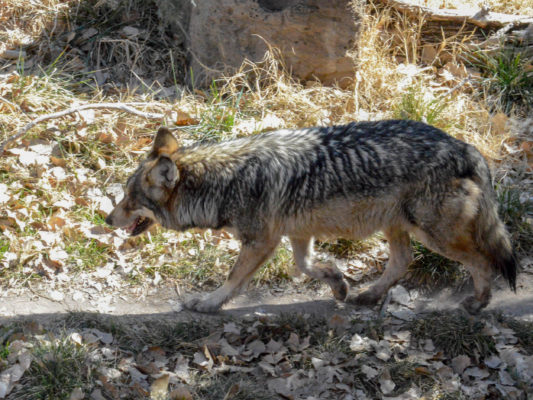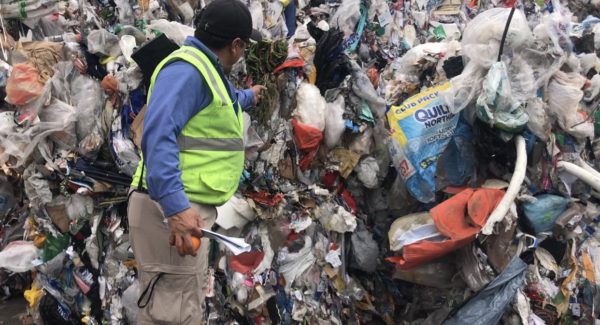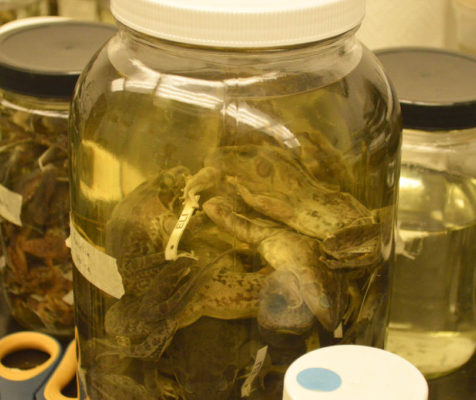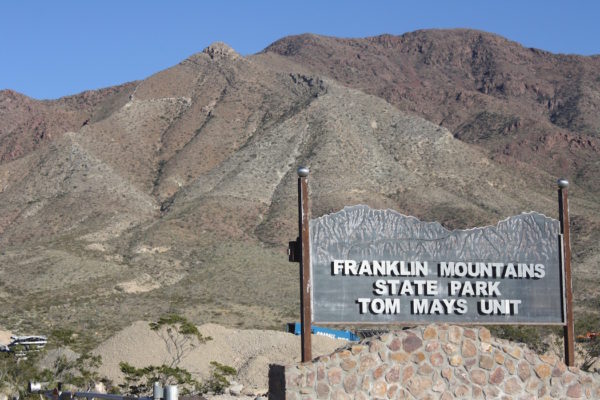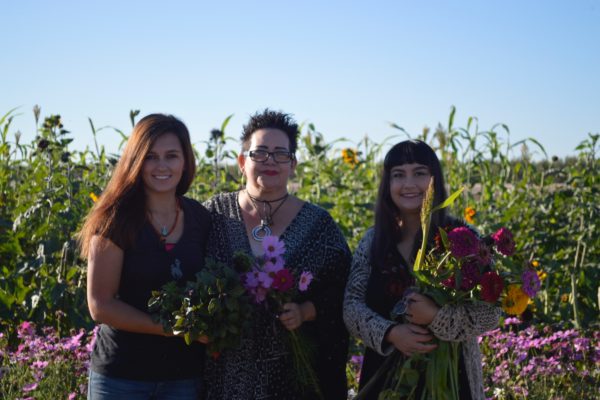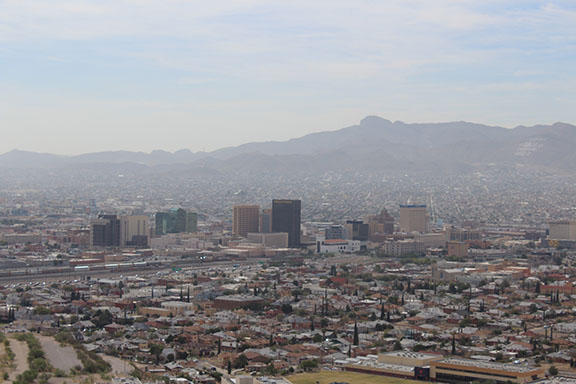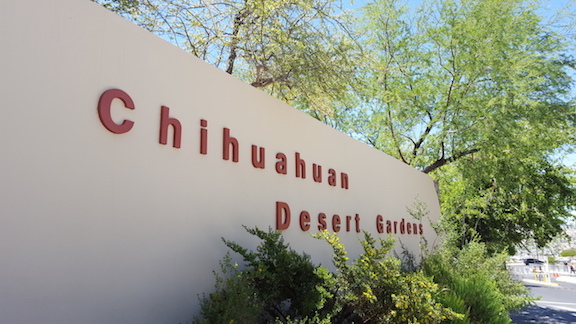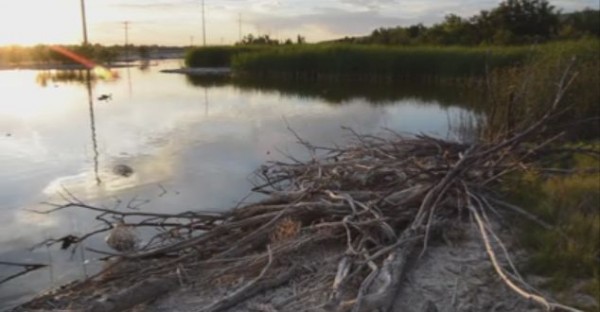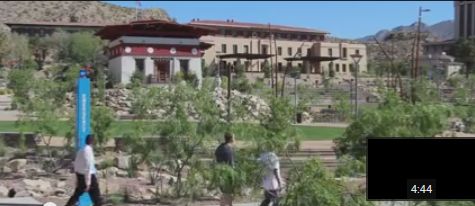SAN ELIZARIO, Texas – This small border city in the Chihuahuan Desert is known for farming high water usage crops, like cotton and pecans, but the high heat and lack of rain from climate change is changing the traditional techniques of home gardeners.
Lorenzo Luevano was born and raised in San Elizario, and got his first taste of agriculture at a young age when his grandmother introduced him to gardening. Now in his late 20s, Luevano serves as the city’s agriculture manager, teaching residents in this low-income community how to grow their own fruits and vegetables in desert conditions.
Adapting cities to a hotter world: 3 essential reads
|
By Jennifer Weeks, The Conversation
Heat waves can be deadly, especially when they combine high temperatures with elevated humidity levels that make the air feel even hotter. The impacts can be especially strong in cities, which often are several degrees warmer than nearby rural areas due to the urban heat island effect. These three articles from The Conversation’s archives describe steps that communities can take to adapt as climate change makes heat waves more frequent and intense. 1. Offer many cooling options
Emergency cooling centers are one way to mitigate the effects of heat waves, but cities need to do more.
Light pollution improved in El Paso, but more can be still be done
|
Dark Sky advocates say that El Paso’s 14-year-old light pollution ordinance has made a difference for stargazing in the Sun City. “I’m happy to say that the light pollution in El Paso is practically gone,” said Marcia Turner, a community activist who helped push for the 2005 city ordinance that required changes in municipal and business lighting practices to help keep the stars visible in the night sky. Before the Dark Sky ordinance, Turner said stores would often compete for business by using bright lights which not only added a heavy amount of light pollution but made it difficult for people’s eyes to adjust. “Notice the stars that you can see now, that you couldn’t before,” Turner said. In 2003, scientists at the McDonald Observatory in Fort Davis, Texas, reported that they could see El Paso’s light pollution even though they were 200 miles away.
In San Elizario, Texas, residential growth competes with cotton farming for land
|
Many Borderlanders may not realize that El Paso County’s Lower Valley is one of the nation’s largest cotton producers. But the valley’s historical farming communities like San Elizario, Texas, face a struggle to continue working the land. “Cotton farming in San Elizario can be traced back to the early 19th century in the El Paso Lower Valley,” says Orlando Flores, of Texas A&M Agrilife Extension Services. “Originally the county produced grapes, the Mission Grapes, but died off due to a fungus. After that, cotton was introduced into the valley.”
Today’s border reality: River hazards, refugee child trauma; an end to migrating wildlife
|
There are many perils for humans and wildlife crossing the U.S.-Mexico border, from the hazards of navigating challenging terrain to the trauma of being detained by law enforcement. As tensions rise with each newly erected section of border wall, the impact of hardline policies can be seen taking a toll on the mental, physical, and environmental health of the borderland. Rising waters threaten migrants crossing Rio Grande
Risks to migrants crossing into the U.S. near El Paso have increased with the annual release of Rio Grande water from upriver in New Mexico. The release replenishes the borderlands and allows its farmers to irrigate, but the surge of water and migrants is a potentially deadly combination. Migrants who bypass barriers at U.S. ports of entry to seek asylum by crossing the Rio Grande risk drowning in the high water of the borderland canals.
Bees lead researchers to trailblazing ecological partnership with Texas city
|
SAN ELIZARIO, Texas – What started as a project by Auburn University to study ways to protect a unique ecosystem of bees in the Chihuahuan Desert has lead to a series of pioneering environmental renovation projects for this historic frontier city on the eastern edge of El Paso County. While fewer than 10,000 people live in San Elizario, the area is special to researchers because it is home to one of the largest diversities of bee species and bee pollinated plants in North America. Auburn University researchers began working with the City of San Elizario in studying the bees in 2017. They soon realized there was more going on that deserved further study. “We were very much bee-centric and now we actually think much more in terms of the ecological interactions between plants and insects.
This guy loves the scent of rain in the desert so much he figured out how to bottle it
|
El Pasoan Kyle Alvarado has captured the sweet smell of the Borderland after a rainstorm in a bottle. His product has “one main purpose and that is aromatherapy“ Alvarado said while at the Onawa Studio, a holistic care and wellness center where students practice the connection of the mind, body and spirit, including aromatherapy. Alvarado studied communication at UT El Paso and is a writer and digital content specialist who previously worked with the El Paso Times and various local media outlets. Drawn to new and creative ideas, Alvarado took a fresh approach to aromatherapy. “Originally I wanted to make rain-scented candles,” Alvarado said.
Penguins chilling in the desert? El Paso zoo creating $3 million home for threatened species
|
The El Paso Zoo will soon become home to a colony of Magellanic penguins – a species listed as threatened by an international organization – in a new multi-million dollar exhibit as part of the city’s 2012 Quality of Life bond issue. Magellanic penguins, which reside along the coasts of South America and reach as far north as Brazil, are small – about two feet tall – with black and white feathers and banding on their necks. They are commonly found in Argentina, Chile and the Falkland Islands. “The more people learn and read about them, the greater their passion will before wanting to help,” said Rick LoBello, education curation for the El Paso Zoo. “We want people to be emotionally invested and passionate about the animals here.”
A dozen penguins will be part of a South American exhibit, set to open in 2020, officials said.
Federal moves to rein in wild horses raising concerns for the American West
|
By Dan Ross, FairWarning.org
Wild horses have long been an evocative symbol of the American West. When wild horses and burros were threatened with extinction nearly 50 years ago, Congress rode to the rescue with a law providing broad protections. Horse numbers have soared, however, along with government costs to manage the herds. And the animals increasingly compete with privately owned livestock for food and water on public lands—a conflict worsened by climate change. There is broad agreement that something has to give.
Mexican Gray Wolf slowly making its way back to Texas
|
Four decades ago, Rick LoBello discovered his life’s passion as he watched several wildlife experts capture an endangered Mexican wolf in South Texas for a preservation project. “When I saw one of the last wild Mexican wolves in 1978 I began my quest to help save the species and to help return it to the wilds of Texas,” said LoBello, educational curator at the El Paso Zoo. At the height of its time, the Mexican Gray Wolf could be seen in abundant numbers. According to the Gray Wolf Conservation, between 250,000 and 500,000 wild wolves lived in harmony with Native Americans. “Not many people know this, but the last Mexican wolf in Texas was actually killed near Big Bend National Park which was near where I lived.”
Disease that is killing bats making its way through Texas, heading west towards Carlsbad Caverns
|
More than seven million hibernating bats were killed by a disease known as white-nose syndrome in 2006 and the disease shows no sign of abating, threatening Texas bats, officials said. Area bats, which play an important role in our society eating pesky insects and pollinating plants, have not caught the disease. However, bats in Central Texas have shown signs of the disease lately, said Rick LoBello, educational curator at the El Paso Zoo. The disease “travels about 200 miles a year,” said Rod Horrocks, a cave management specialist at Carlsbad Caverns National Park said. It is inevitable area bats will contract the disease in coming years, LoBello said.
El Paso Water works to encourage restaurants to conserve with its seal of approval
|
El Paso Water has been working on conservation programs for residents for nearly 20 years. Since the start of the initiative in the 1990s, per capita consumption has been reduced by over 20 percent, according to research by the utility. Although EPW said every resident’s conservation effort is important, the companyt is now concentrating conservation efforts on encouraging restaurants and businesses to reduce their water use. “We found that about 15 percent of the water use from the commercial sector comes from hospitality and the food service industry,” Christina Montoya, communications and marketing manager for El Paso Water, said. In May of 2017, Montoya and her team developed the idea to recognize restaurants that have been successful in conservation by deeming them as Certified Water Partners.
China’s tougher recycling laws put squeeze on Borderland’s blue bins
|
El Pasoans are mixing too much trash with their curbside recycling, so officers from the city’s Environmental Services Department are checking bins to insure residents are in compliance. The crackdown comes as recycling costs have skyrocketed due to contaminated materials. Last year China, which is considered the world’s largest consumer of recyclables, told the World Trade Organization that it no longer will accept any sub-standard solid waste, including soiled popular recyclable items like plastic and paper. The new policy went into effect on Jan. 1 and is having a big impact on U.S. recyclers.
UTEP professor’s new book recounts adventures in the Congo and work on species extinction
|
With his shaved head and graying goatee and loads of adventures to relate, UTEP professor and geneticist Eli Greenbaum resembles a modern-day Indiana Jones. He has survived two major expeditions to the Congo, several bouts of malaria and been confronted by machine-gun totting tribal villagers. His work over the last 10 years has been focused on researching how to repopulate the decreasing amphibian and reptilian population of the African nation. “There was this one area (of the Congo) where I went to a really remote place and the local tribe thought I had come to drink their blood,” said the 6-foot-tall professor who is in his late 30’s. His experiences in the field are soon to be public knowledge with an about-to-be released book about his work and experiences in the Congo.
Riding through change
|
By Laura Montelongo
Throughout the past few years downtown El Paso has experienced many transformations as a community. Many people overlook the fact that even though construction is taking over the area, there is a popular biking movement. Taking a turn down the road of Downtown El Paso, we notice the many beneficial things our city has to offer the community is palpable. In September of 2015, Bcycle started their company with a total of 80 bikes and eight stations to place all 80 bikes. The development of bike usage has increased drastically from June 2015 to June of 2016 receiving one thousand participants, and is constantly increasing today.
Preparation is the key to hiking the Franklin Mountains
|
Hiking the mountains and trails in El Paso are an appealing attraction to residents and tourists alike, but it is not just a simple stroll up and down. There are many ways that novice hikers in the Franklin Mountains might end up in need of rescue, such as losing the trail, not being able to find a way down after dark, or even a potential medical emergency. Losing the trail is a very common occurance, due to individuals not paying attention to the trail, or venturing to explore beyond established trails and not being able to find their way back. Also, hikers need to make sure that they plan the duration of their hike accordingly. You need to plan for your hike up, rest time, as well as hike down.
The top recycling mistakes El Pasoans make every day
|
Nine years after the start of a curbside recycling program, city workers say El Pasoans still don’t get it. “Within the last few years, we have seen the contamination rate of non-recyclable items in the blue container dramatically increase,” said Raeann Ortega Recycling, manager of the Environmental Services Department with the city of El Paso. Ortega said people are frequently tossing non-recyclables into their blue bins, which increases costs for labor to sort out at the city’s recycling centers. “Within the last twelve months we spent approximately $750,000 in processing fees,” Ortega said. The most common mistake residents make is putting Styrofoam containers and pizza boxes in the blue bins or taking inappropriate items with their recyclable items to one of four citywide Citizen Collection Sites (CCS).
Air pollution leads to lower grades for some El Paso schoolchildren, study finds
|
El Paso’s poor air quality is driving down school performance for children in neighborhoods with high rates of airborne metabolic disrupting chemicals, researchers say. In a study published in the September issue of the International Journal of Environmental Research and Public Health, researchers at the University of Texas at El Paso and Northeastern University looked at school performance among fourth and fifth-grade public school children in El Paso. They found that children exposed to higher levels of airborne toxins had lower grade point averages,
Related: Air quality one of biggest threats on U.S., Mexico border
Study author Stephanie Clark-Reyna, a second-year doctoral student at Northeastern University who attended UTEP as an undergraduate, said she hopes the research will have an impact on how El Paso addresses its unique air quality issues. “Air quality in El Paso is concerning because of the trucking industry. Last time I looked it up, something like 800,000 trucks passed through a single port of entry in one year,” Clark-Reyna said.
El Paso florist teams with New Mexico flower farm to create ethical arrangements
|
EL PASO – When Juliana Varkonyi and her mother Mary Ibanez decided to open a flower shop, they knew they wanted it to reflect a sense of community and respect for the environment. That’s why they decided to open Desert Modern Florals in Downtown El Paso and then partner with Calhoun Flower Farms based in southern New Mexico. The shop is in the center of the Cortez Building downtown, across the street from the newly renovated San Jacinto Plaza. Ibanez said they chose the downtown location because of the revitalization that is going on right now. She wanted the business to be part of the emerging community.
Bowie High School students gear up to launch sustainable food truck business
|
Starting a business can be a risky and tedious endeavor. Yet six Bowie High School seniors have taken on the challenge with a donated school bus, the support of school officials and assorted contributions from local businesses. If all goes according to plan, business seniors Sophia Morales, Veronica Rodriguez, Andres Valdez, Joseph Gutierrez, Sergio Marrufo, and Sisco Gonzalez, all age 17, will soon be selling healthy food options out of the Oso Good Food Truck to raise money for college scholarships. The student-run food truck business, slated to hit the streets in January, is a partnership with Bowie’s International Business Academy in partnership with EPISD, El Paso Custom Food Trucks, Bowie Garden Resources, and now Whole Foods Market. The six seniors enrolled in the International Business Academy at Bowie produced the business plan.
Ciudad Juárez no cuenta con la tecnologia para medir el aire contaminado
|
La contaminación ambiental es un problema que afecta a todo el mundo, no respeta fronteras. El aire es un elemento natural que es compartido por la frontera norte de México, por Ciudad Juárez, Chihuahua, El Paso, Texas y el condado de Doña Ana. El problema mas importante que esta enfrentando Ciudad Juárez es que el equipo con el que cuentan para medir la contaminación ambiental trabaja con tecnología de los años 80’s. El Índice Metropolitano de la Calidad del Aire, mejor conocido como el IMECA, se utiliza en distintas ciudades de México. El hecho de que este equipo es muy viejo no sirve para medir el IMECA, por lo cual no se le puede informar a la comunidad del nivel de contaminación ambiental.
Air quality one of the biggest threats on U.S., Mexico border
|
EL PASO – Lower Valley resident Daniela Caro struggles to breathe some days. “On bad days my asthma gets really bad, my throat closes up, even walking to class is a little bit hard,” she said. The 23-year-old El Pasoan lives near Riverside where trucks spew toxic fumes as they transport goods across the El Paso-Juarez border. The American Lung Association ranks El Paso’s pollution in the top 20 among U.S. metropolitan areas for both particles and ozone. Poor air quality has been linked to health issues, particularly for at-risk groups like children, older adults and anyone with respiratory problems like asthma.
Obama urged to make El Paso’s Castner Range a national monument
|
In the Northeast region of El Paso, Texas there lies more than 7,000 acres of land next to the Franklin Mountains that may be most known for the yellow Mexican poppies that blanket the foothills come springtime. Now, the golden field of Castner Range may also be known as a national monument thanks to efforts by a coalition of El Pasoans pushing to preserve it for future generations. The Frontera Land Alliance and the Franklin Mountains Wilderness Coalition teamed up to promote protecting the land from housing and commercial development. In December 2015, El Paso Congressman Beto O’Rourke introduced legislation (HR 4268) to establish Castner Range as a national monument. Now, a public push is gaining momentum to urge President Obama to protect the area by using the Antiquities Act to designate it as a national monument.
Look again to see the wonders growing in the desert
|
EL PASO – Is that scrappy plant on the side of the road a weed or a wonder? Desert landscapers say there’s often more to the Borderland’s flora than meets the eye. The term weed is usually meant for a plant that is considered a nuisance, growing where it isn’t always wanted, says John White, curator of the Chihuahuan Desert Gardens at UT El Paso. But where some people see weeds, others see wildflowers, healing herbs and critical sustenance for desert wildlife and other helpful uses. “Some of the weeds are actually good, some of the weeds can be edible, and some of them can be used for different purposes,” White says.
El Pasoans can get native plants, gardening tips at the Chihuahuan Desert Gardens Florafest
|
Gardening in El Paso can go far beyond the the gravel and cactus that so many people believe is their only choice. A walk through the Chihuahuan Desert Gardens at UTEP is a good place to find inspiration. More than 700 native plants make up the lush and colorful landscape nestled like a secret oasis next to the Centennial Museum. Bursting in blues, pinks and magenta, Salvia Greggi or Autumn Sage dwell in the deep dark corners of the gardens. Constantly in bloom, the Angelita Daisy’s seize the light and your eyes.
El Paso’s role in the once mighty metal smelting industry preserved at UTEP library
|
For more than 100 years the American Smelting and Refining Company, ASARCO, loomed large on the El Paso landscape. From its purchase of a copper refining plant in Smeltertown in 1910 until its massive towers were demolished in 2013, ASARCO was a major icon of El Paso’s role in the history of the mining industry. In this video, Borderzine multimedia reporter Ariadne Venegas walks us through the UT El Paso library exhibit on the history and impact of El Paso’s metal ore processing operations with ASARCO. Former employees share their memories of working at the plant.
Politicians, scientists discuss widespread U.S. water issues at White House summit
|
By Luke Torrance, SHFWire.com
WASHINGTON – The United States does not have a major water problem – it has several major water problems.
That was the realization of Jeffery Lape, the deputy director of science and technology at the Environmental Protection Agency, after meeting with officials from several states over the past year. California is in the midst of an historic drought. Rivers in the Pacific Northwest have become hotter, harming salmon populations. Cities around the country are facing the same problems as Flint, Mich.: contaminated water and deteriorating distribution systems.
So Lape gathered groups from across the country March 22 for the White House Water Summit. The meeting was held in the Eisenhower Executive Office Building next to the White House.
Sticks beat science in low-cost search for water
|
Water witching (also called divining or water dowsing) is a practice used to locate ground water using a stick, rod, pendulum, or something similar. With the drought going on in the El Paso area, a lot of people are searching to have wells built for their farm or backyard. Robert Garcia is someone people go to before they begin the process of starting a water well, which can cost up to thousands of dollars. He said he uses the technique of water witching to identify the best location for finding water. Who can do it?
Wetlands, retired professor offer refuge to wildlife
|
Emu eggs used to fetch $100 apiece. Now, they’re worthless. After people started
releasing the ostrich-like birds, Carol Miller adopted four at her wildlife rescue. The emus joined a menagerie of other abandoned, injured and abused animals at
Miller’s home in El Paso’s Upper Valley. People bring her baby rabbits, squirrels,
ducks, geese, songbirds and even snakes.
UT El Paso transforms heart of campus with plaza renovation
|
The University of Texas at El Paso unpaved parking lots, roads and walkways, and transformed the space into paradise, according to landscape architect Christine Ten Eyck. The Centennial Plaza project, which created a common area featuring native vegetation, arroyos and bubbling fountains in an amphitheater setting, was part of a $25 million renovation project timed to the university’s 100-year anniversary. University officials said the plaza, “will continue to contribute to a sense of community, and offer students greater opportunities to excel.”
A major feature of the plaza is a Bhutanese lhakhang, a temple that had been installed on the mall in Washington, D.C., in 2008 as part of a cultural exchange. It was transported beam by beam to El Paso, and opened in April. Artisans from Bhutan painted lush Buddhist scenes on the altar, walls and interior columns.
